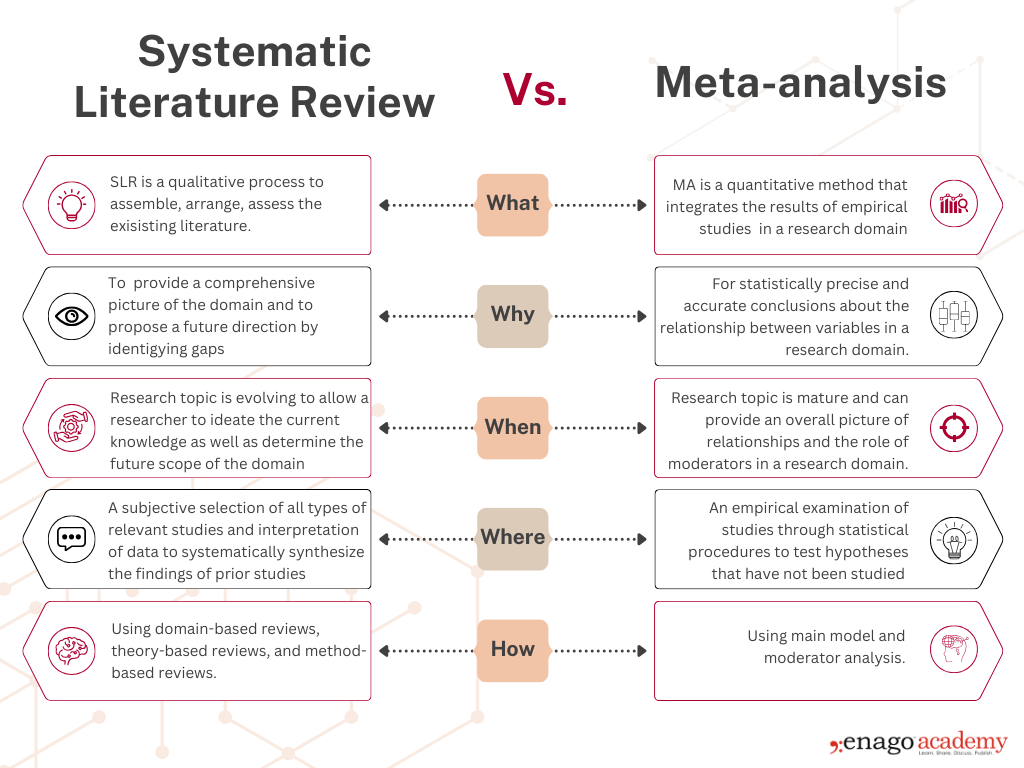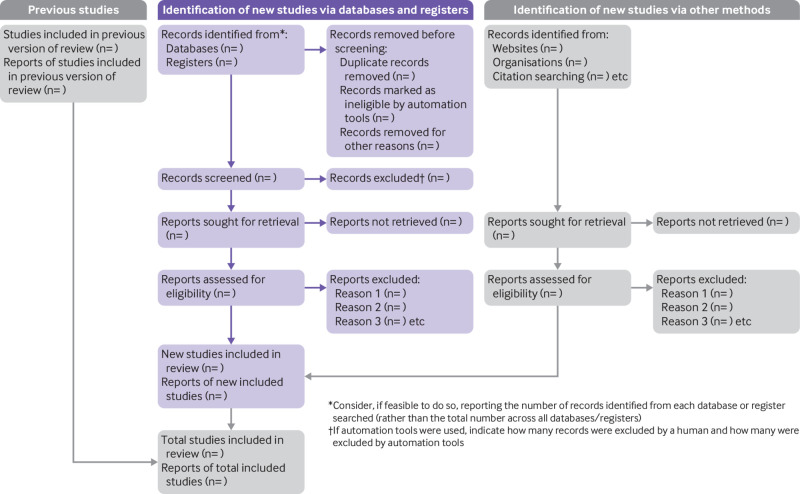Systematic Literature Review Vs. Meta-Analysis: Understanding evidence synthesis

Systematic reviews also known as Systematic Literature Reviews (SLRs) and meta-analyses are cornerstones of evidence-based research. These terms are often used interchangeably, as both involve the examination of existing research. However, they serve distinct purposes. Understanding these methods is crucial for researchers and practitioners aiming to conduct impactful studies.
What is a Systematic Literature Review?
A systematic literature review is a detailed summary of research on a specific topic. It involves gathering, analyzing, and critically evaluating data from published studies to provide a clear and reliable synthesis of the evidence. An SLR is the gold standard for summarizing existing research in any domain.
The process begins with a clearly defined research question. Researchers widely use PICO (Population, Intervention, Comparison, Outcome) and SPIDER (Sample, Phenomenon of Interest, Design, Evaluation, Research type) as search frameworks for literature reviews. They primarily apply PICO to clinical and intervention-focused research questions, while they turn to SPIDER as a valuable alternative for qualitative research.
An SLR involves a comprehensive search strategy to identify all relevant studies. Then you must meticulously screen the studies using predefined inclusion and exclusion criteria to ensure transparency and reproducibility.
What is a Meta-Analysis?
Meta-analysis is a subset of systematic reviews that uses statistical techniques to integrate and analyze data from multiple studies. These are highly effective when the included studies share similar methodologies, interventions, and outcome measures. Meta-analyses resolve conflicting findings across studies and identify overall trends.
SLRs that include meta-analysis, provide a quantifiable understanding of the evidence, helping researchers and decision-makers derive actionable insights.
Difference Between Systematic Literature Reviews and Meta-Analyses
 The above infographic shows that SLRs and meta-analysis are closely related methods that complement each other in evidence synthesis. While a meta-analysis focuses on statistically combining data from multiple studies to derive a comprehensive result, it relies on the structured approach of an SLR to identify and evaluate relevant research. To conduct a high-quality meta-analysis, understanding the key steps in a systematic review is essential.
The above infographic shows that SLRs and meta-analysis are closely related methods that complement each other in evidence synthesis. While a meta-analysis focuses on statistically combining data from multiple studies to derive a comprehensive result, it relies on the structured approach of an SLR to identify and evaluate relevant research. To conduct a high-quality meta-analysis, understanding the key steps in a systematic review is essential.
How to Perform a Systematic Literature Review?
The Preferred Reporting Items for Systematic Reviews and Meta-Analyses (PRISMA) statement is a set of reporting guidelines developed to improve the quality of reporting in systematic reviews. It includes a checklist of 27 essential items (as of the updated version released in 2020) to be reported in systematic reviews. The below flow diagram is a general guideline to refer before starting an SLR.

Source: The PRISMA 2020 statement: an updated guideline for reporting systematic reviews | The BMJ
After reviewing the flow diagram, you have a general understanding of the intricate processes involved in conducting an SLR. It is crucial to exercise caution when considering data from non-peer-reviewed sources, such as unindexed websites and registries. Below are few key steps that can be used as a guide while performing an SLR.
Key Steps for Conducting an SLR:
- Start by formulating a research question with an appropriate scope
- Conduct a thorough review of existing literature to identify gaps and ensure your work does not replicate previous studies, where you can employ the help of literature review services.
- Also, consider registering your protocol on public platforms, such as PROSPERO or Figshare (to ensure transparency and avoid overlap with other researchers)
- Next, collect all retrieved records in a reference manager (to remove duplicates before screening)
- Use a structured approach for screening studies, start with titles and abstracts followed by full-text reviews based on your predefined inclusion and exclusion criteria
- Assign two independent reviewers to ensure accuracy
- Extract data from the selected studies to assess the risk of bias in the included studies
- Then present the results clearly, including detailed methodology and search strategies to ensure the review can be easily updated in the future
- Finally, perform a meta-analysis if the studies included have similar designs and outcome measures
Key Steps for Conducting a Meta-Analysis:
- Define a focused and specific research question
- Identify relevant studies
- Calculate effect size for each study to quantify and summarize their findings
- Use meta-regression to analyze the heterogeneity amongst these using appropriate software like R or Stata
- Code the effect sizes with the study data, analyze the data for outliers, publication bias, and model (random or fixed effects)
- Report the results highlighting effect sizes and statistical significance (forest plot or funnel plot to visually detect publication bias)
- Offer recommendations based on the strength of the evidence
- In cases where evidence is insufficient, suggest future research directions
- Find the best journal for publishing your systematic review to ensure your research reaches the appropriate audience
Need a list of all the essential tools and resources to perform all the above steps in an SLR and meta-analysis in one place?
Grab our COMPREHENSIVE TOOLKIT here!
Each method has advantages and limitations, especially in dealing with heterogeneity and weighing evidence. A meta-analysis offers a more scientific approach compared to traditional bibliometric SLRs. It can reconcile conflicting findings and better understand relationships within a research domain. However, challenges such as handling heterogeneity, assessing publication bias, and choosing appropriate models must be carefully managed. Qualitative synthesis in SLRs offers flexibility in handling diverse study designs but can make it challenging to draw generalizable conclusions. Additionally, both methods require careful consideration of study quality and the risk of bias. As these factors can heavily influence the final interpretation of the evidence.
The choice between the two methods should be based on the study’s specific needs. These include points like the research question, type of intervention being analyzed, and outcomes of interest. Finally, choosing the right method will ensure that the evidence gathered is both relevant and reliable. This will ultimately generate deeper and impactful insights in the study domain.










